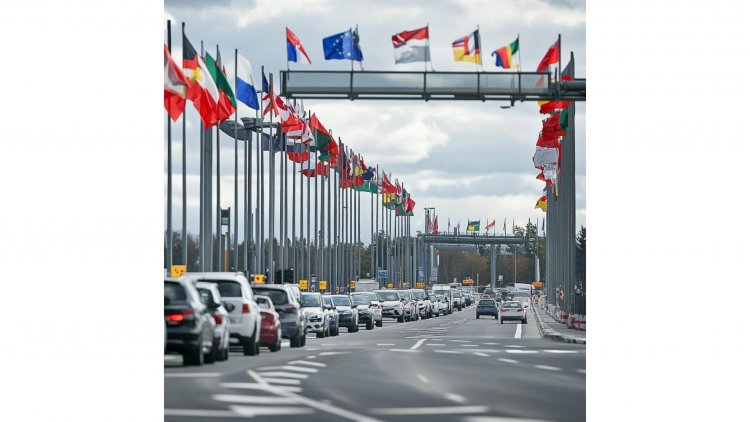Border-Hopping by Car: 6 Unconventional Tips for Seamless International Travel
Embarking on an international road trip offers unparalleled freedom and adventure, but crossing borders by car comes with its own set of unique challenges. From navigating customs regulations to ensuring your vehicle is roadworthy, there are numerous aspects to consider to make your journey smooth and enjoyable. To help you prepare for a hassle-free border-crossing experience, we’ve compiled six essential tips that will keep you on track and stress-free as you explore new countries by car.

1. Know the Entry Requirements of Your Destination
When driving across international borders, it's crucial to be well-informed about the entry requirements of the countries you plan to visit. Each country has its own set of regulations regarding visas, vehicle documentation, and health requirements.
Visas and Travel Documents
Before embarking on your trip, ensure that you have the necessary visas for each country you’ll be entering. Some countries may allow visa-free entry for short stays, while others might require a visa in advance. Double-check the expiration dates on your passport as well, as many countries require passports to be valid for a certain period beyond your intended stay.
Vehicle Documentation
Your car will also need proper documentation. This includes registration papers, proof of insurance, and, in some cases, a permit for international driving. Many countries require that your insurance policy covers you for driving abroad, so contact your insurance provider to confirm that you're covered.
Health Requirements
Health regulations can vary widely. Some countries might require proof of vaccinations or a recent health check-up. In recent times, health protocols have been particularly stringent due to global health concerns, so it's wise to check for any specific health entry requirements or travel advisories related to COVID-19 or other health issues.
2. Prepare Your Vehicle for International Travel
A well-maintained vehicle is essential for any road trip, but international travel demands even more preparation. Ensuring that your car is in top condition will help you avoid unexpected breakdowns and legal complications at the border.
Vehicle Inspection and Maintenance
Before setting out, have a comprehensive vehicle inspection done by a professional. This should include checking the engine, brakes, tires, lights, and fluids. A breakdown in a foreign country can be not only inconvenient but also potentially costly, so preventive maintenance is key.
Emergency Kit
Equip your car with an emergency kit that includes basic tools, a spare tire, first-aid supplies, and essential fluids. Additionally, consider including a flashlight, a blanket, and non-perishable food items. In some countries, having specific safety equipment, such as warning triangles or reflective vests, might be a legal requirement.
Roadside Assistance
Verify if your roadside assistance coverage extends to international travel. If not, you might want to purchase additional coverage that provides assistance across borders. This can be incredibly valuable if you encounter any issues while traveling through unfamiliar areas.
3. Understand Local Road Rules and Regulations
Different countries have varying road rules and regulations. Understanding these before you cross the border can prevent legal issues and ensure a safer journey.
Driving Laws
Research the driving laws of each country you will enter. This includes speed limits, alcohol consumption limits, and rules regarding mobile phone use while driving. For example, some countries have strict laws about the use of seat belts and child safety seats, and failing to comply can result in hefty fines.
Road Signs and Markings
Familiarize yourself with common road signs and markings used in the countries you’ll be visiting. This can help you navigate roads more effectively and avoid misunderstandings with local drivers. International road signs are often standardized, but there can be regional variations that you should be aware of.
Toll Roads and Fees
Many countries have toll roads and congestion charges. Check if the countries on your route use electronic toll collection systems or require physical tickets. Some regions may also have specific fees for using certain types of roads or crossing particular areas.
4. Plan Your Route and Accommodations
A well-planned route can enhance your travel experience and ensure that you’re prepared for border crossings and overnight stays.
Route Planning
Use up-to-date maps and GPS navigation systems to plan your route. Consider potential detours and road closures, and be aware of the border crossing points and their operating hours. Some borders may have specific hours of operation or be subject to delays during peak times.
Accommodation
Make reservations for accommodation in advance, especially if you’re traveling during peak tourist seasons. Look for hotels or motels near the border crossings or within the regions you plan to visit. This can reduce stress and provide a comfortable place to rest after a day of driving.
Local Services
Identify local services along your route, such as gas stations, restaurants, and repair shops. Having this information handy can be particularly useful in less populated areas or if you need assistance in an unfamiliar location.
5. Currency and Payment Methods
Handling money while traveling across borders can be tricky, so it’s important to be prepared.
Local Currency
Carry some local currency for each country you will visit. While credit and debit cards are widely accepted, some areas, particularly rural or remote regions, may only accept cash. Exchange a small amount of money before you leave or use currency exchange services as you travel.
Payment Methods
Ensure your credit or debit cards will work internationally. Notify your bank or credit card company of your travel plans to avoid having your cards flagged for suspicious activity. Also, be aware of any foreign transaction fees that might apply.
Budgeting
Set a budget for each country and track your spending. This will help you manage your finances and avoid running short of money. Keep receipts and record expenses to stay within your budget.
6. Communication and Safety
Staying connected and ensuring your safety are paramount when traveling across borders by car.
Communication
Ensure you have a reliable means of communication, such as an international phone plan or a local SIM card. Having access to maps, translation apps, and emergency services can be incredibly beneficial. It’s also wise to share your itinerary with family or friends and provide them with updates about your whereabouts.
Emergency Contacts
Familiarize yourself with local emergency numbers and have a list of important contacts, including local embassies or consulates, in case you need assistance. Knowing how to reach out for help in different countries can provide peace of mind and ensure you're prepared for any situation.
Travel Insurance
Purchase comprehensive travel insurance that covers vehicle breakdowns, medical emergencies, and other unforeseen events. Insurance can be a lifesaver in case of accidents, theft, or other issues, and provides an additional layer of security while traveling abroad.
With these tips in mind, you’re better equipped to handle the complexities of crossing international borders by car. Each journey is unique, so stay flexible, keep informed, and most importantly, enjoy the adventure.
Navigating international borders by car can be an exhilarating experience, but it requires thorough preparation and awareness of various factors. By following the tips outlined above, you'll be better prepared to handle the challenges and enjoy a seamless journey.
As you plan your cross-border road trip, remember that each country has its own set of regulations and requirements. Keeping informed and proactive about documentation, vehicle maintenance, road rules, and local customs will help ensure that your travel experience is both enjoyable and stress-free. Embrace the adventure, stay adaptable, and let the open road lead you to new discoveries.
Disclaimer
The travel information and recommendations on this blog are intended for general guidance and inspiration. Conditions and regulations can change quickly, so please verify all details with appropriate sources before making travel plans. We are not liable for any errors, omissions, or outcomes resulting from your use of this information. Travel involves inherent risks, and it's essential to prioritize your safety and well-being. Always travel with adequate insurance and take necessary precautions.
What's Your Reaction?





















